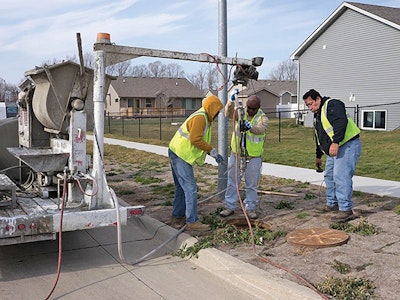
Interested in Manholes?
Get Manholes articles, news and videos right in your inbox! Sign up now.
Manholes + Get AlertsDes Moines is Iowa's largest city, but with a population of only 203,000, it deserves its reputation as a quiet, prosperous community. In recent decades, however, Des Moines has been tested severely by two major flood events. The "Great Flood of 1993" was the most devastating flood in U.S. history, according to the U.S. Geological Survey, and the Iowa Flood of 2008 was so devastating that it caused about $64 billion in damage and is referred to as, 'Iowa's Katrina.'
So Des Moines' sewer system deals with occasional intense flooding and high groundwater, and it's an aging system. "Our main sewer infrastructure in most of the city is about 100 years old, and it's almost all brick — brick lines and old brick manholes," explains Des Moines Section Chief Rick Powell, who is in charge of manhole rehabilitation and levee maintenance.
For five years, the City of Des Moines has been sealing and structurally rehabilitating failing brick manholes without contractor assistance, using the PermaCast system and AP/M PERMAFORM's City Self-Install Program. The city has already rehabilitated 1,000 of its 18,000 manholes, saving approximately $3,000 per manhole over reconstruction. Powell says the savings have already paid for the system in the first two years of the program.
Even before the city bought their own application equipment, they used the system in test projects to evaluate the solution over time. Some of these date back 15 years and are holding up well with no sign of failure. That long-term performance convinced Powell that the PermaCast system is cost-effective and durable.
"I think it saves taxpayers a lot of money in the long haul, and from what we've seen it will greatly extend the useful lifespan of our aging manholes," Powell says.
A good system
Des Moines' experiences with AP/M PERMAFORM actually go back about 20 years, when the company's president, Bill Shook, demonstrated a manhole cleaning system based on high-pressure spin washing. That system evolved into PermaCast, which uses a patented, bi-directional robotic spincaster to apply thin layers of high-strength, fiber-reinforced cementitious grout to the interior of failing manholes.
Prior to signing up for the self-install program, Des Moines didn't have a formal protocol for manhole repair. When manholes failed completely, they'd be rebuilt with new materials. Various patching methods were also used from time to time. "These weren't very good," Powell says. "It seemed like they ended up breaking down after just a few years."
Now, the city systematically rehabilitates manholes prior to failure. They don't have a fixed annual goal for the number of manholes to be rehabilitated, but they do take advantage of good conditions. "When the weather is good, we're able to repair up to five manholes a day," Powell says, "That's with an average depth per manhole of 10 to 12 feet."
Making it like new
Manhole surfaces must be thoroughly cleaned prior to rehabilitation. Some also require patching before spin-casting. Manholes can be wet to the touch, but for the system to be effective there can be no running water. If hydrostatic pressure is detected, patches or plugs are used to stop any inflow.
Once the manhole has been cleaned and prepared, the PermaCast spincaster is lowered from above, eliminating the need for confined-space entry. The bidirectional feature is important. Since the spray nozzle spins in one direction on the descent — clockwise or counterclockwise — and the opposite direction on the way up, there are typically no concrete "shadows" caused by uneven bricks or other protrusions. This eliminates handwork. The result is a smooth, watertight, completely structural new manhole that tightly adheres to and stabilizes the existing manhole. PermaCast can be used to repair brick, concrete or even steel manholes.
Sewer flow does not need to be stopped during the application process. The system does not cover the inverts, but those can be done by hand if necessary. Temperatures must be above 50 degrees, and curing typically takes four to six hours.
The grout used is typically MS-10,000, or another specialty grout from AP/M PERMAFORM. These are specially formulated for manhole rehabilitation, and if microbiologically induced corrosion is an issue, they can be mixed with ConmicShield, an antimicrobial additive that provides permanent corrosion protection.
"It's a good system, and it lines the old manhole from top to bottom," Powell says, "We usually apply a 1/2-inch-thick layer of concrete in one complete pass, and we find that that is completely structural. If the old manhole is failing or especially bad, we might do another layer after the first layer has cured, for a total of about an inch."
Training was initially provided by AP/M PERMAFORM staff who visited the site and worked with Des Moines crews in the field. But since then, Powell says, on-the-job training has been more than sufficient to get new employees started on the PermaCast crew. "It's not really too complicated a process," he says. "It's become routine for us, and we treat it as an entry-level job for new employees. So, we have a lot of turnover on that crew, but we're always able to consistently do high-quality work."
Like many cities, Des Moines struggles to keep up with pressing infrastructure maintenance issues while coping with shrinking budgets. In the case of manhole rehabilitation, the city has learned that sometimes, doing it yourself is the best way to go.
About the Author
Angus W. Stocking, L.S., is a licensed land surveyor and a full-time infrastructure writer.







